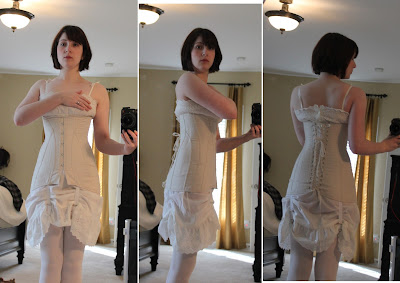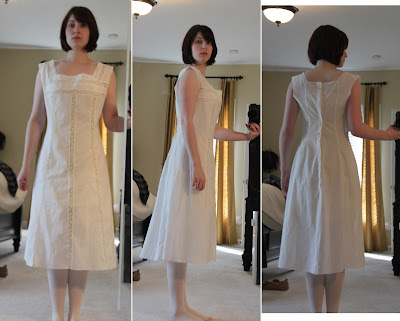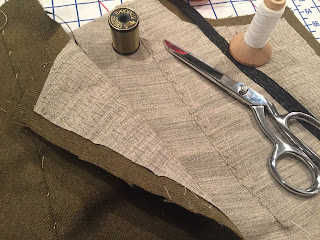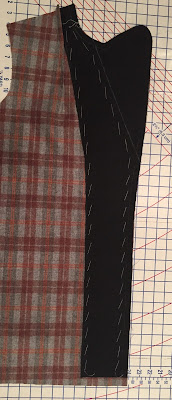A growing list of free books on the internet dealing with tailoring, drafting, and dressmaking.
The Taylor's Instructor, 1809. Figures for men's garments and a ladies habit.
Rules and Directions for Cutting Men's Clothes, 1822. Basic Drafts.
A Treatise on Cutting Garments to Fit the Human Form, 1841. Measuring and numerous drafts for coats, waistcoats, trousers, and more.
A Plain and Concise Treatise of the Art of Tailoring, 1844. Drafting, unfortunately the plates are not unfolded.
The Archetypal Consummation, 1845. Measurements and drafting for coats and waistcoat.
The Tailor's Transfer, 1846. A method for measuring and drafting.
The Tailor, 1840s? The tailors methods, caring for garments, detailed construction, and basic drafts.
Art du Tailleur, 1855. Drafts to standardized measures.
Manual, 1866. Basic Drafts.
The Tailor, 1867. Method for measuring and drafting.
Gazette of Fashion, 1868/9. Fashion plates and their drafts.
Gazette of Fashion, 1869/70. Fashion plates and their drafts.
H. Matheson's Scientific and Practical Guide, 1871. Cutting layouts and fashion plates.
Systems for Garment Cutting, 1872. Basic Drafts.
A Scientific Guide to Practical Cutting, 1873. Basic Drafts.
Gazette of Fashion, 1881. Fashion plates and their drafts.
Vest Cutting, 1883. A variety of vest drafts.
Practical Handbook for Tailors & Seamstresses, 1883. Basic Drafts.
Standard Work on Cutting, 1886. Basic Drafts.
The Science of Coat and Vest Cutting, 1891. Basic Drafts.
Stone's Paramount Cutter, 1891. Basic Drafts.
Garment Cutting in the 20th century, 1892. Basic Drafts.
The American Tailor & Cutter, 1892. Basic Drafts.
The American Coat, Vest, & Trousers System, 1895. Basic Drafts.
The Modern Designer, 1900. Basic Drafts.
The Americanized French Cutting System, 1906. Basic Drafts.
The A.D. Rude Great Modern System, 1906. Basic Drafts.
Grand Edition of Supreme System, 1907. Large variety of drafts.
The Standard Work on Cutting, 1908. Women's drafts for tailors.
Stone's Scientific System, 1912. Grading drafts.
New Supreme System, 1917. Large variety of drafts.
Designing Sack Coats, Dress Coats, & Vests, 1918. Basic Drafts.
Streiff's Ideal System of Garment Cutting, 1920. Basic Drafts.
Coat Making at Home, 1941. Instructional tips, including fur trim.
How to Tailor a Woman's Suit, 1946. Step-by-step instructions.
Artistic Dressmaking and Cutting, 1895. Construction for basque and skirt.
Standard Tailor System, 1896. Drafts for women and children.
Artistic Ladies' Tailor System, 1902. Drafts and instructions for men, women, and children.
System of Garment Drafting, 1904. Dressmaking drafts for women and children.
The American System of Dressmaking, 1907. Construction techniques, including "Tailor-made suits"
The Taylor's Instructor, 1809. Figures for men's garments and a ladies habit.
Rules and Directions for Cutting Men's Clothes, 1822. Basic Drafts.
A Treatise on Cutting Garments to Fit the Human Form, 1841. Measuring and numerous drafts for coats, waistcoats, trousers, and more.
A Plain and Concise Treatise of the Art of Tailoring, 1844. Drafting, unfortunately the plates are not unfolded.
The Archetypal Consummation, 1845. Measurements and drafting for coats and waistcoat.
The Tailor's Transfer, 1846. A method for measuring and drafting.
The Tailor, 1840s? The tailors methods, caring for garments, detailed construction, and basic drafts.
Art du Tailleur, 1855. Drafts to standardized measures.
Manual, 1866. Basic Drafts.
The Tailor, 1867. Method for measuring and drafting.
Gazette of Fashion, 1868/9. Fashion plates and their drafts.
Gazette of Fashion, 1869/70. Fashion plates and their drafts.
H. Matheson's Scientific and Practical Guide, 1871. Cutting layouts and fashion plates.
Systems for Garment Cutting, 1872. Basic Drafts.
A Scientific Guide to Practical Cutting, 1873. Basic Drafts.
Gazette of Fashion, 1881. Fashion plates and their drafts.
Vest Cutting, 1883. A variety of vest drafts.
Practical Handbook for Tailors & Seamstresses, 1883. Basic Drafts.
Standard Work on Cutting, 1886. Basic Drafts.
The Science of Coat and Vest Cutting, 1891. Basic Drafts.
Stone's Paramount Cutter, 1891. Basic Drafts.
Garment Cutting in the 20th century, 1892. Basic Drafts.
The American Tailor & Cutter, 1892. Basic Drafts.
The American Coat, Vest, & Trousers System, 1895. Basic Drafts.
The Modern Designer, 1900. Basic Drafts.
The Americanized French Cutting System, 1906. Basic Drafts.
The A.D. Rude Great Modern System, 1906. Basic Drafts.
Grand Edition of Supreme System, 1907. Large variety of drafts.
The Standard Work on Cutting, 1908. Women's drafts for tailors.
Stone's Scientific System, 1912. Grading drafts.
New Supreme System, 1917. Large variety of drafts.
Designing Sack Coats, Dress Coats, & Vests, 1918. Basic Drafts.
Streiff's Ideal System of Garment Cutting, 1920. Basic Drafts.
Coat Making at Home, 1941. Instructional tips, including fur trim.
How to Tailor a Woman's Suit, 1946. Step-by-step instructions.
Artistic Dressmaking and Cutting, 1895. Construction for basque and skirt.
Standard Tailor System, 1896. Drafts for women and children.
Artistic Ladies' Tailor System, 1902. Drafts and instructions for men, women, and children.
System of Garment Drafting, 1904. Dressmaking drafts for women and children.
The American System of Dressmaking, 1907. Construction techniques, including "Tailor-made suits"



















































